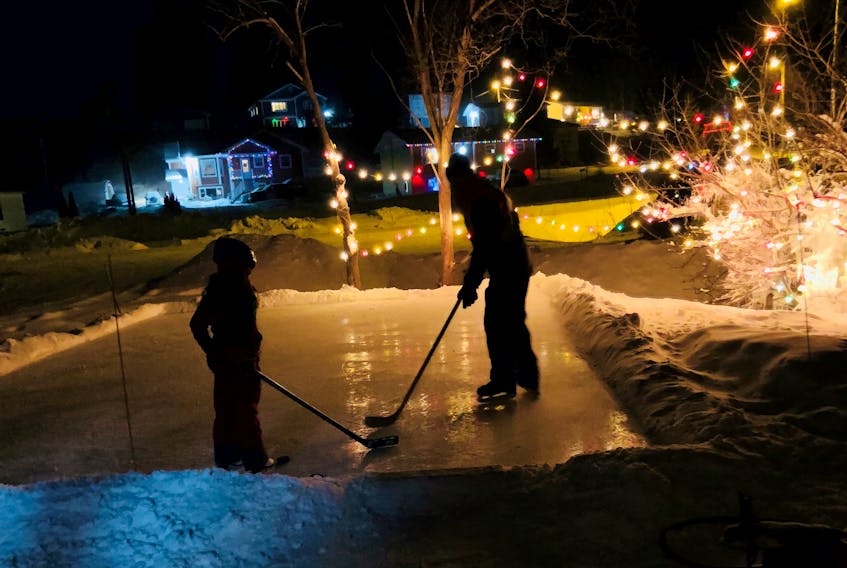Aimee Maynard and her husband both wanted to have a skating rink in their backyard when they were growing up.
When the couple, who now live outside Corner Brook, N.L. had a daughter, they decided to build one, thinking it was a great way to make memories.
To make it, Maynard says they bought a huge rink liner on Amazon and built a large wooden frame themselves from scrap wood. Keeping it going, she says, takes a lot of time, consistency, and patience.
Now, every New Year’s, they have a big skating party with a fire, snacks, hot chocolate, and of course, fireworks. This year she’s undecided if the party will proceed. Between COVID-19 restrictions and the predicted weather, they are going to have to wait and see.

Plenty of work
Having a rink that is usable requires a lot of work, says Paul Veinotte. The Port Williams, N.S. man has been building a backyard rink for the past 11 years.
Before you start, you need to make sure you have as flat an area as possible, Veinotte says.
Not only that, but you might need adequate drainage in the spring, adds Darren Kruisselbrink from Kentville, N.S., another veteran backyard rink builder of over 30 years.
Veinotte begins the process by spreading out a plastic tarp and wrapping the ends under a series of one-inch by 12-inch boards. This tucking helps prevent the tarp from getting cut from skates or pucks. Then, he staples the tarp to the boards before filling it with water to freeze.
Each year, Veinotte buys a new tarp to ensure there are no holes in it, as it can be very frustrating to spring a leak. Some people use silage wrap, which is more durable and often lasts for more years, but it's more expensive than a tarp, he says.

Kruisselbrink recommends sourcing plastic from a greenhouse business, but whatever you use, Veinotte says to make sure that one side of the plastic is white.
If you don’t gather your own supplies, Kruisselbrink says there are kits available, which consist of a plastic bag that is filled up with water and then frozen. If you go that route, though, you are limited to that pre-determined rink size.
Another option is making a rink without using the boards and plastic. Kruisselbrink used to pack down the snow in the backyard by putting a couple of kids on a toboggan and dragging them around.
“I always thought an easier way would be to stomp around the area in a pair of snowshoes, but I don’t own a pair, so that was only ever a flight of fancy,” he says.
Then, spray a few layers of mist over the area to start building an icy base. Once the area is sealed by the mistings, flood the rink a few times until you get a solid base, says Kruisselbrink. This method avoids plastic altogether.
"The main point is to flood the rink when it's cold, like below zero," says Veinotte.
And that might mean you are out really late to take advantage of the weather. Some people will flood with hot water, he says, noting that works best, but costs more than just running a normal outside tap.
"You also don't want snow or flurries after a flood because it will pebble (make bumps on the ice), so a clear night is the best scenario," says Veinotte, who meticulously pays attention to weather reports.

Challenging weather
Kruisselbrink floods his rink three to four times a week, something he calls a "labour of love."
"When we’re using it, it gets pretty scratched up and we always seem to be patching one area or another. And with the thaw-freeze weather cycles, what starts out as a flat space tends to suffer from frost heaves," he says.
When maintaining the rink, Veinotte also tries to keep leaves out of the ice, as they will melt holes. This is one of the hardest things to do, depending on your area.
But no matter how much time spent on construction and maintenance, it could all be for naught.
“The winter weather in Nova Scotia is so unreliable that all the work I put into making a good base could disappear in 24 hours with an abrupt rise in temperature,” says Kruisselbrink, noting in the last few years, his family has only been able to get two to three good weeks of skating on the rink.
"Global warming," he says.
Veinotte agrees, saying it's important to enjoy doing it to make it worthwhile.
"Even if you only get on it a few times. I have had winters like that, and it can be frustrating," he says.
“You have to look at the positive time you did have to skate. You have to be patient; rinks don't always go well.”
When asked if it is worth the effort to build a backyard rink these days with the mild weather, Kruisselbrink says no.
"It would probably be easier to look for a frozen pond," he says.
Unless you are passionate about building one. Choosing a smaller size, says Veinotte, is easier to maintain and less of a time commitment. The size you build depends on the age of the kids and how many kids might be on it at a time.

Competitive rinks
Once you have your rink perfected, you might be able to enter it into a competition.
For the past several years, The Home Depot in Charlottetown, P.E.I. have paired up with the Charlottetown Islanders junior hockey team for an annual backyard rink contest, says Aidan Northcott, the team’s director of communications and sales.
Last season, Northcott says five local rink entrants took a picture of their rink and submitted it. A winner was selected from the submissions.
Last year’s winner was Jessica Pigott, who had a great backyard rink that essentially played host to the community on a nightly basis, says Northcott. Pigott was to win a face-off against the Charlottetown Islanders with the players visiting her winning rink for a little shinny and a skills session with local children.
“Unfortunately, on the day the event was planned to happen, the weather was too warm and we weren’t able to get on the ice,” explains Northcott. “The next scheduled day fell after the pandemic, so that, too, was cancelled.”
The Home Depot has had to scale back their efforts in the Canadian junior markets because of the pandemic, so the contest won’t happen this year, says Northcott. But that shouldn’t discourage people from continuing to build backyard rinks, he says.
"Backyard rinks are a fantastic way of encouraging physical activity for those both young and old, especially in the winter," says Northcott. "As well, they act as a great developmental tool for those looking to improve in hockey - and an even better introductory tool for those who are just getting into hockey."









